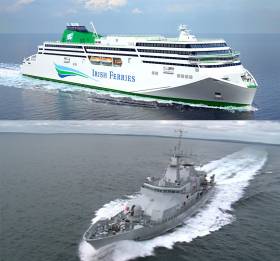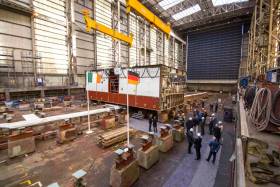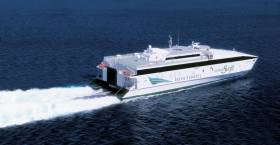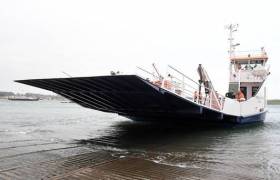Displaying items by tag: Irish Ferries
#FerryFestive - An Irish Ferries cruiseferry on the French route based out of Rosslare returned yesterday prior to making a repositioning voyage to Dublin Port this morning in preparation of the busy festive season, writes Jehan Ashmore.
Cruiseferry, Oscar Wilde had completed a Cherbourg-Rosslare crossing. This was followed by the 1,400 passenger/700 car ferry transferring to the Irish capital to begin sailings on the core Irish Sea central coridoor route to Holyhead.
Sailings by Oscar Wilde on the French route have been suspended so to enable firstly the above mentioned capacity increased on the premier UK-Ireland route. In addition the absence of the ferry is to permit annual winter dry-docking of the 1987 built cruiseferry that is scheduled to return to the French service in February 2018.
As of late this morning Oscar Wilde made a first crossing to Holyhead and is due to return to Dublin this afternoon. Also running services to cope with the inward bound influx of seasonal passengers on the Wales-Ireland link are flagship cruiseferry Ulysses, fast-craft Jonathan Swift and ropax ferry Epsilon.
The chartered-in Epsilon, will operate Ireland-France sailings during the absence of Oscar Wilde from Wexford based sailings in 2017, but take heed of the following next scheduled sailings and ports used in both directions.
Afloat can confirm the next outward sailing to the continent is Dublin-Cherbourg and will be after Christmas, on Wednesday 27th December. The next inbound sailing to Ireland will however call instead to Rosslare, arriving on Friday 29th December. For further subsequent sailings details consult Irish Ferries through this link.
Rivals, Stena Line are expected to transport 65,000 passengers over the festive period also on their service between Holyhead-Dublin and on the St. Georges Channel link of Fishguard to Rosslare.
Information on Irish Sea routes, sailing dates, crossing times and more click here for Irish Ferries and for those travelling with Stena Line click here. From this webpage there are also links to their Cherbourg-Rosslare service.
For those travelling on P&O Ferries click this link, noting the weatherline applies to both routes: Liverpool-Dublin and Cairnryan-Larne.
In addition should there be any ferry travel delays, disruptions and cancellations, they are included on the AA’s Roadwatch newsroom here.
Irish Ferries Retains 'Best Ferry' Title
The 26th Irish Travel Trade Awards ceremony was an event to celebrate once again for Irish Ferries as they were honoured with the ‘Best Ferry Company’ title for the 11th year in succession.
Held at a gala ceremony in Dublin recently and attended by a large number of guests from the travel industry, awards were presented on foot of independent votes cast by travel trade professionals working in agencies across Ireland, north and south.
Their latest success means Irish Ferries continues to hold the two key ‘Best Ferry Company’ titles from Ireland’s travel trade, having also been awarded the top honour at the 2017 Irish Travel Industry Awards. In addition, the Company also received the ‘Best Ferry Company’ award at the Group Leisure & Travel Awards in the UK earlier this year.
Accepting the accolade, Irish Ferries head of passenger sales Dermot Merrigan thanked Irish travel agents for their continued support, adding: “Irish Ferries is honoured to receive this award which, in our eyes, is an independent acknowledgement of the work we have been doing and the investment we have made over many years to improve the standard and quality of service that our customers can expect.”
Currently, the company is building the new €144million, 55,000 tonnes cruise ferry, W. B. Yeats – which will be the largest and most luxurious ferry ever to sail on the Irish Sea when it enters service on Irish Ferries’ Dublin - Holyhead and Ireland - France routes next Summer.
Ferry Operator ICG Revenue Up As Traffic Increases
#FerryNews -Consolidated revenue at Irish Continental Group (ICG) operator of Irish Ferries, increased by 3.1pc to €288.9m year-on-year in the ten months to 31 October.
Total revenues writes The Independent for the group’s ferries division was €184.4m, a 1.4pc increase on the prior year. The increase in revenue was driven by an increase in the number of cars and container freight that ICG carried.
For the year to 11 November, Irish Ferries carried 385,100 cars, an increase of 2.2pc on the previous year. Freight carryings for the year to 11 November were 247,700 roll-on roll-off, an increase of 0.5pc compared with 2016.
Despite the weakness in sterling, ICG managed to partly mitigate revenues affected by sterling with improvements in its sterling-based costs. However the company said that fuel costs continued to be impacted by higher global fuel prices compared to this time last year.
Total revenues recorded in the group’s container and terminal division recorded in the period to 31 October amounted to €111.2m, a 5.9pc increase on the prior year. For the year to 11 November container freight volumes shipped were up 5.5pc on the previous year at 281,000 teu, with the rate of growth slowing to 3.8pc in the period since 30 June.
Units handled at the group’s terminals in Dublin and Belfast increased 3.2pc year on year to 258,400 lifts. For more on the maritime transport logistics operator, click here.
Daily Departures from Irish Ferries to France for Summer 2018
#DailytoFrance - A new sailings schedule from Irish Ferries will be introduced following the arrival in mid-2018 of its new 55,000 tonnes cruise ferry W. B. Yeats currently being built in Flensburg, Germany.
Highlights of the plan will see a doubling in the number of summer sailings between Ireland and France – offering daily departures alternatively from both Dublin and Rosslare ports. This is coupled with an increase in autumn/winter sailings frequency, and an expansion in passenger, car and freight carrying capacities on the company’s prime Ireland – UK route between Dublin and Holyhead.
Described by its managing director, Andrew Sheen, as a plan “to be welcomed by all interests and one that will give a significant boost to Irish tourism and trade”, the proposed new sailings and scheduling arrangements will, he said, “give passengers and freight customers alike, more choice in terms of routes and departure dates, particularly on services to France.”
When delivered, the new W. B. Yeats will be the largest and most luxurious ferry ever to sail on the Irish Sea. It will have space on board for 1,885 passengers and crew, 1,200 cars in 4kms of vehicle deck space, and 441 cabins, with a variety of cabin grades including luxury suites. A waiter service a la carte restaurant, choice of lounges, an outside promenade deck and a host of entertainment options are amongst its other features.
Ireland – France
On Ireland – France routes, the introduction of W. B. Yeats will enable Irish Ferries to double the current number of sailings between the two countries with planned daily departures in alternate directions.
On the Dublin – Cherbourg route, new arrangements will see the W. B. Yeats operate up to four return sailings weekly on what is becoming an increasingly popular route for the summer season. In parallel, the company’s scheduled services from Rosslare to the French ports of Cherbourg and Roscoff - operated by the cruise ferry Oscar Wilde - will include an increase in the number of summertime departures to the popular Breton port of Roscoff. In the off-peak winter season, the vessel Epsilon will replace the W.B. Yeats providing a year–round service from Dublin to the Continent for both freight and tourism customers.
Ireland – UK
From mid-September next, W. B. Yeats will transfer to the busy Dublin – Holyhead route. There it will take up service alongside the existing Irish Ferries vessel Ulysses to deliver a ‘significant three-fold benefit’ that Irish Ferries believes will be wholly welcomed by tourist, business and import/export customers.
Adding its passenger and vehicle carrying capacity to that of Ulysses – the world’s largest car ferry when introduced in 2001 – the move will see customers benefit from an increase in sailings frequency and an expansion in the passenger, tourist car, coach and freight carrying capacity that its introduction on this busy route will bring. Given this additional investment in the route, the Dublin Swift fast ferry will operate a summer only schedule next year and will return to Irish Sea service in early April 2019.
July 2018 arrival
Looking ahead to the launch of W. B. Yeats and its arrival into Dublin next July, Andrew Sheen said: “the service we envisage post its introduction is one that will raise ferry travel to new levels of luxury, comfort and reliability never before offered in the Irish marketplace”.
”We know our customers will be pleased with our investment and we look forward to welcoming them onboard our new luxury cruise ferry next summer,” he added.
Why Has Irish Ferries Chosen The Same Name as the Navy?
Hello and you’re welcome to the weekly MacSweeney Podcast…
The procedures and practices involved in the naming of ships once appeared to be the product of evolution and tradition, then became the choice of politicians – at least as far as the Irish Naval Service is concerned - and of on-line polling where the ferry company, Irish Ferries, is involved.
So, there will be two vessels called after the poet William Butler Yeats……
The Naval Service’s L.E. William Butler Years - P63 - is the third of the recent additions to its fleet. Classed for offshore patrol, she cost €71m and was commissioned a year ago in Galway and named by a granddaughter of the poet.
Irish Ferries has decided to name its new €144m ferry, costing double the price of the Naval vessel and now being built in Germany, also after the poet who was born in Sandymount in Dublin and died in France…. The company says the name will be “important in overseas markets drawing a high degree of recognition” and that it chose ‘WB Yeats’ after an online competition which attracted 100,000 entries.
Managing Director Andrew Sheen said the name “continues the tradition adopted by the company of selecting names from the world of Irish literature.” The name, he said, will “sit comfortably alongside those other great literary figures whose names adorn other vessels in the Irish Ferries fleet” but some of which are registered outside of Ireland – in Cyprus and the Bahamas.
The Government decision, which was opposed by Naval officers past and present and by sections of public opinion, ended the tradition of naming Irish Navy patrol vessels after mythical female figures. It was controversial when the Cabinet ignored Naval opinion. The Department of Defence said the naming of ships after “world renowned literary figures” would “facilitate greater recognition for the Naval Service in the international maritime domain”.
On that score Irish Ferries’management seems to agree….
It is not uncommon in the shipping world for vessels to have similar names, but is generally avoided to prevent confusion. Two ships operating in Irish waters - named after the same Irish poet does invite questions – why – and will the duplication of names cause confusion?
So far, there’s been no comment from the Navy or the Department of Defence on the duplication…
Irish Ferries Chooses ‘W. B.Yeats’ As Name For New Cruise Ferry
Irish Ferries has chosen W. B. Yeats as the name for its new €144 million cruise ferry now being built in Germany for service on routes between Ireland, UK and France. The name was chosen after it had drawn ‘strong support’ from the public in an online competition that attracted nearly 100,000 entries.
According to a spokesman: ‘it was clear from the poll that there is widespread public affection for W. B. Yeats, due in the main to the magnificence of his writings and his contribution to Irish society, theatre and the arts generally’.
Acclaimed as one of the greatest poets of the 20th century and one of Ireland’s foremost literary figures, W. B. Yeats was born in Dublin and educated in Ireland and London.
Recipient of a Nobel Prize for Literature, he helped to found Dublin’s Abbey Theatre. Amongst the poems for which he is most fondly remembered is ‘The Lake Isle of Innisfree’, a composition inspired by his many holiday visits to Sligo, where, in a churchyard beneath Ben Bulben, his remains now rest.
The decision by Irish Ferries to name their new vessel W. B. Yeats is one that continues the tradition adopted by the company of selecting names drawn from the world of Irish literature.
Commenting, its managing director, Andrew Sheen said: “In choosing W. B. Yeats from the many whose works are revered by Irish people and students of literature the world over, we have selected one that will give the new vessel its own distinct identity and stir memories of a poet who is held in high esteem by so many, here and abroad”.
In addition to the weight of public support that W. B. Yeats received, operational factors that influenced its choice included the importance of picking a name that would have a high degree of public recognition and appeal in those overseas markets into which the vessel will operate and from which Ireland draws a significant volume of its tourism and trade.
Ships’ registration, regulation and other operational and legal aspects also ranked amongst the factors that needed to be considered, as was the desire to choose a name that would sit comfortably alongside those other great literary figures whose names adorn other vessels in the Irish Ferries fleet.
Noting that W. B. Yeats is one that will need no introduction to people across the world, Andrew Sheen said: “It is a name that will convey a sense of the magnificence and grandeur that passengers can expect when travelling on our new vessel, sailings of which are expected to commence on the Dublin – Holyhead and Ireland – France routes from mid-Summer next year”.
When built, the W. B. Yeats will have space for 1,885 passengers and crew, 1,200 cars and 440 cabins including luxury suites with their own private balconies. Other facilities will include a Club Class lounge with direct passenger access from the car decks, á la carte and self-service restaurants, cinema, shopping mall, choice of bars and lounges and exclusive areas for freight drivers. Pet owners will also be comforted in knowing that dedicated facilities for pets are also being provided on board.
Noteworthy in the context is that Sandymount, where Yeats was born, is located on the city’s southern coastline from where residents can look out upon the shipping channel into Dublin port along which the vessel that will bear his name will sail.
Leitrim woman wins free travel for life after suggesting Yeats’ name
The choice of W. B. Yeats as the name for the new vessel has proven to be a lucky link for Co. Leitrim woman, Lee Maxwell from Manorhamilton. Living close to Yeats’ beloved Co. Sligo, Lee’s good fortune in being chosen from the huge number of participants who suggested the poet’s name is said by Irish Ferries to be proof of what a ‘magical’ choice the name W. B. Yeats is. Picked from the thousands who shared her choice, Lee’s prize of free travel for life will be presented to her shortly.
Big Shipyard for a Big Irish Ferries Ship
When it arrives here next July, Irish Ferries says it will be the largest and most luxurious cruise ferry operating on the Irish Sea. Little wonder then that it would be built in a very large shipyard indeed.
Yesterday, Afloat.ie reported on the keel laying ceremony that took place in the shipyard of Flensburger Schiffbau-Gesellschaft where it is being built with a photograph of the Irish Ferries delegation, led by managing director Andrew Sheen, that was present to witness the proud occasion.
In this view of the giant yard taken at the event, a number of those present can be seen dwarfed by the huge keel section as they examine it close up, and by the overall scale of the shipyard building itself in which the new ferry is being built. All going well, the vessel is expected to arrive into Ireland in mid-2018, July being the date mentioned.
Afloat.ie readers have been making suggestions for the new ship's name here
Strong Irish Ferries Presence at Keel Laying Ceremony
A delegation of senior Irish Ferries officials today attended the keel laying ceremony for a new €144million, 55,000 tonnes cruise ferry being built on behalf of the company in Flensberg, Germany.
Due to be delivered next July, the new vessel will be the largest and most luxurious ferry ever to sail on the Irish Sea. It will enter year-round service on the Dublin – Holyhead and Ireland – France routes.
On board, it will have space for 1,885 passengers and crew, 440 cabins including luxury suites with their own private balconies, and almost 3km of car deck space. Other facilities will include a Club Class lounge with direct passenger access from the car decks, á la carte and self-service restaurants, cinema, shopping mall, choice of bars and lounges, exclusive areas for freight drivers, and dedicated facilities for pets.
In accordance with tradition on such occasions, Andrew Sheen presented the shipyard with a ceremonial coin, specially commissioned by Irish Ferries to mark the occasion, which was placed within the keel section to remain there throughout its construction in order to bring good luck and calm seas for the vessel.
Afloat.ie readers have being suggesting names for the new ferry here, 'Seamus Heaney' is a popular choice and 'Brian Ferry' gave us a chuckle
Storm Ewan Disrupts Sunday Ferry Sailings On Irish Sea
#StormEwan - Hot on the heels of last week’s Storm Doris, there is further ferry disruption today (Sunday 26 February) as Storm Ewan brings strong gusts to the East Coast.
Irish Ferries has cancelled its 8.45am and 2.30pm sailings from Dublin to Holyhead, as well as its 11.50am and 5.15pm return trips, all on the Swift, due to the adverse weather conditions forecast for the Irish Sea.
Met Éireann has issued a Status Orange national weather warning and gale warning as south to southwest winds are expected to reach Force 8-9 with storm force gusts on coasts from Malin Head to Carnsore Point to Valentia and on the Irish Sea.
Small craft are also warned as west to southwest winds will reach Force 6 or higher from Valentia to Slyne Head to Malin Head.
The most damaging gusts of up to 120kmh are expected along southern coasts, with a wind warning issued for Wexford, Cork, Kerry and Waterford until early this afternoon.
A Status Yellow warning is in place over mean wind speeds upwards of 50kmh and gusts of up to 110km in all other coastal and some Midlands counties in Leinster.
#Old&New – Fresh from annual dry-docking is Isle of Inishmore of Irish Ferries, that recently resumed Rosslare-Pembroke duties, writes Jehan Ashmore.
The 34,000 gross tonnage cruiseferry had undergone routine maintenance work at A&P Falmouth, Cornwall. This year marks 20 years since Isle of Inishmore made a debut in 1997 for owners, Irish Continental Group. The custom built ship firstly began operations for ICG's ferry division on the Dublin-Holyhead route.
Built by Van der Giessen-de-Noord, Krimpen aan den Ijssel, Rotterdam, Isle of Inishmore carries 2,200 passengers. This makes the cruiseferry still one of the largest in terms of capacity in northern-western Europe. In fact she carries more than that of flagship Ulysses of 1,875, though the larger 50,000 gross tonnage giant carries more cars and trucks.
Last month Isle of Inishmore had relieved Ulysses on the Dublin-Holyhead route, which saw the flagship drydock instead at Cammell Laird, Birkenhead. Currently at the Merserside facility is fastferry Jonathan Swift following completion of similar work. The craft having vacated the dry-dock shifted to the nearby wet basin.
Aside shiprepairs, Cammell Laird also build vessels including the £6.2m newbuild, Strangford II which was completed last year for the Department for Infrastructure (DfI) in Northern Ireland. In recent days reports the Belfast Telegraph, the 28 vehicle ferry finally began service on Strangford Lough following teething problems with vehicle loading ramps as previously reported.
As for Isle of Inishmore’s return to the ferry scene at Rosslare Europort (see report: Irish Rail 30th) this led to relief cruiseferry Oscar Wilde head also for Cornwall. An overhaul of the eldest fleetmember at the south-west UK shipyard will be carried out prior to taking up seasonal service to Cherbourg, France that begins on 1 March.
The fifth member of Irish Ferries fleet, the chartered-in ropax, Epsilon has in recent weeks carried out freight-only runs between Dublin and Rosslare. They have taken place in between routine rosters on weekly Dublin-Holyhead sailings. In addition the Italian flagged ropax sailings on the year-round operated Irish capital-continent connection to Cherbourg.
This morning Epsilon docked at the Normandy port. At the same time French service rival, Stena Line (albeit serving out of Rosslare) saw relief ropax Stena Nordica also make an in-bound call.




































































